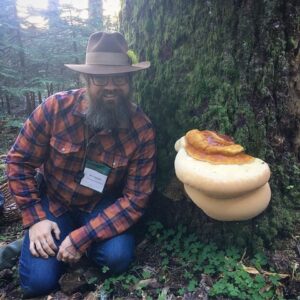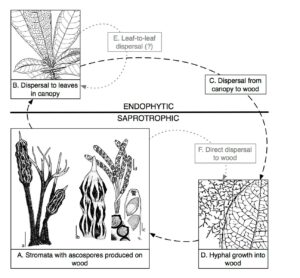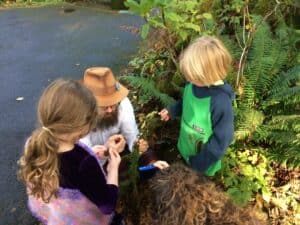Who are you and how is your work influenced by nature?
I’m a queer mycologist and illustrator who likes to ponder the overlap between art and science. To be a little more specific, I’m a PhD researcher at the University of Oregon, and one of the world experts in the family of fungi called the Xylariaceae.
Wow, that sounds so technical. Basically, I’m someone who has always had a love of the natural world, and a desire to learn and understand as much as I could about it. That’s why I got my PhD — because I wanted to know and understand as much as I could. One thing they don’t tell you when you start a PhD is that an essential part of the process is developing new knowledge: to get a doctorate, you have to learn something that no one has ever learned before, and then you get to add that to the pool of all human knowledge. You become the world expert on something, and that’s a process I wasn’t really expecting, but one that changed me (for the better, I think).

For my part, I became an expert in the ecology and classification of a group of fungi called the Xylariaceae. I helped build up a new ecological theory about how fungi move around in the world, linking wood decay fungi and plant symbionts with an idea called viaphytism. But that’s a whole other story.
My work, both scientific and artistic, is completely influenced by nature. How could it not be, since we’re all a part of nature anyway? In science, I’m interested in the way that different parts of an ecosystem interact with each other: how the plants and the fungi relate, converse, help, or hurt each other. In art, I’m interested in much the same things. I take all my inspiration from nature, and consider myself to be a part of nature too: if we’re going to survive, as a species, we have to think about the way that we live in the world, the feedbacks between ourselves and the rest of the organisms that we share the planet with.
That’s why there’s a strong conservation theme throughout my work. Right now, I’m exploring the intersection of art and science by producing a feature-length documentary film, called Marrow of the Mountain. This isn’t really a science documentary, although there is science in it: it’s about three Ecuadorian women—an indigenous leader, a Black farmer, and a scientist—who are fighting to save their rainforests, communities, and ways of life from encroaching large-scale mining. I’m working with an excellent team of Ecuadorian and American filmmakers to bring this project to life; it’s been more than two years in the making, and I’m so happy that we’re getting close to finishing it! We’re hoping for a premiere in early 2022, if all goes well.

What was your first memory/experience with the mycelial world?
Oh man, my first memory with mushrooms and fungi? I grew up in southern Appalachia, which is great mushroom country, but doesn’t have the traditional culture of mushrooming that you might expect from how diverse and abundant the fungi are in the Blue Ridge. That’s changing, but I was certainly raised with the classic American fungiphobia (mom: “don’t touch those, they might be poisonous!”).
My first real experience with fungi wasn’t from foraging, or even from mushrooms at all: it was with fungi called arbuscular mycorrhizal fungi, or AMF for short.
You see, I got into fungi by way of an interest in symbiosis. As a college student, I landed a job working in a soil science lab, and I loved it! Mostly, I did really tedious work, like separating all the roots out of a bag of dirt and then sorting them by size (one of the worst jobs in science, apparently), but I got to hang out with the PhD students and the postdocs, I got to attend lab meetings and discuss the same scientific papers as everyone else, I got to really dig in and learn. That lab didn’t even work with fungi at all: the projects I helped with were all about soil nutrients and the like.
But, you can’t work with soil and ecology for long before you run into arbuscular mycorrhizal fungi. Mycorrhizae (from the Greek myco- for fungi, and -rrhiza for root) are the symbiotic mutualists that work with plants to help them survive in the harsh environment of… well, everywhere. Most people are probably familiar with what are called ectomycorrhizae (the ecto- means “outside”, because of the way the fungi grow over the roots).
These are the mushroom-forming fungi that connect trees in the forest and help them gather nutrients and water from the soil; chanterelles and porcinis are great examples, and very delicious too! But AMF, the arbuscular mycorrhizal fungi, are the less well-known, but much more common, group of symbiotic partners. In fact, almost all plants have mycorrhizal fungi, and almost all of those are AMF! The grass in your lawn, the flowers in the garden, even the potted houseplants on your windowsill, probably are living in symbiosis with these arbuscular mycorrhizal fungi. They are a whole different group of fungi, always microscopic, and they don’t make mushrooms at all, but they’re fascinating, important, and beautiful (through a microscope).

So, after I graduated college (and detoured for a couple of years at a medical biotech startup), I took a job as a tech in a lab at University of Pennsylvania in Philadelphia working with these arbuscular mycorrhizal fungi. I was interested in symbiosis ecology pretty generally at first, but once I started down the fungal rabbit hole, I never came back up! That initial interest in symbiosis took me from roots to leaves (where there are always endophytic fungal symbionts!) and down to Ecuador for the first time during the early part of my PhD research.
But, looking back, I sort of wish I’d had the opportunity to get into fungi at a younger age: I feel like I missed out on so much by not starting to learn about these fascinating creatures until I was an adult. I grew up in the part of the USA with the highest mushroom diversity, and I didn’t even know!
I feel like that’s a shame, so I decided to do something about it. I decided to help more people make those lasting mycelial memories at an early age: I’m currently writing a children’s book about fungi! It’ll be the first of its kind, and will let middle grade kids with a thirst for knowledge explore the wonders of fungi. There are so many great kids books about other science topics, like plants and animals, rocks and space, etc, but there really aren’t very many about mushrooms and fungi (and, without naming names, some of the ones out there are pretty bad). I’m being represented by Fuse Literary Agency for this project, and we’re hoping we can bring the book to publication within the next year, so look out!
How do you regularly interact with mushrooms?
The real question is: how do I not!? Kidding aside, I work with mushrooms and fungi every day. From publishing new species to teaching international workshops, I’m steeped in fungi day in and day out.
Lately, my work has been really tied to conservation efforts in Ecuador. You see, the place where I did most of my dissertation research, a protected forest in the northwest of Ecuador called Reserva Los Cedros, was recently included in mining concessions to a Canadian mining company. It’s complicated, but basically the government in Ecuador decided to change the way they interpreted the law so that they could have mining in this class of protected forests (called bosques protectores). Almost overnight there was a 300% increase in the amount of land given over to mining companies, and about a third of Ecuador’s network of bosques protectores was covered in mining concessions, Los Cedros included.

I couldn’t stand still for that, so I helped organize the Richer than Gold biodiversity expedition to help document the rare and endangered species at Los Cedros before the mining company could destroy the forest. We had funding from National Geographic and the American Orchid Society, and participation from more than 20 scientists in Ecuador and the USA — we documented not just fungi, but plants and animals, everything from birds, frogs, monkeys, and pumas, to orchids and trees. But the mycology crew was by far the largest group, and we made more than 300 collections which were donated to the Ecuadorian National Institute for Biodiversity (INABIO) and deposited in the National Herbarium, in Quito.
It’ll take years to work through the data from that expedition, but preliminarily, we think we’ve discovered half a dozen species of fungi previously unknown to science! And, right now, we know that there are more than 200 species at Los Cedros on the endangered species list: more than is known from almost anywhere else in the world!
That expedition was actually the start of the documentary film I’m producing, Marrow of the Mountain, which I talked about earlier. We started out just planning a short film about the expedition (which is coming out soon!), but quickly realized that to really get to the heart of the matter we needed a much more ambitious, feature-length documentary.
And that expedition, and the fungal diversity we’ve uncovered, has had a tangible impact on conservation efforts at Los Cedros: I was asked to present our work at Los Cedros to the Constitutional Court (the highest court in the country, like the Supreme Court here) as evidence in the ongoing case to decide if it is legal for mining to happen within this kind of protected forest. We’re still awaiting the ruling from the Constitutional Court on the case, but right now, it looks like the science we’ve done at Los Cedros, and the mushrooms we’ve documented, might be what saves this precious rainforest from destruction.
What mushroom(s) are you the most inspired by?
Well, I’m a specialist in the genus Xylaria, so I feel like it would be wrong not to say that! You’ve probably seen them: they’re called Dead Man’s Fingers or Candlesnuff Fungus. This is a fascinating genus of mushrooms, and the focus of my PhD research, because of their life cycle.
Xylaria are some of the most common wood decay fungi in the world, eating dead wood and returning their carbon to the atmosphere: they’re huge players in the global carbon cycle because of this. But they’re also some of the most common endophytes—fungal symbionts living in plant leaves, remember—in the world. Why (you might ask) would a wood-decay fungus want to live inside of a living leaf? They don’t eat leaves, remember, and they can’t do much with a living plant, because the plant has its own defense mechanisms.

Luckily, I’ve been spending my career answering that question! It turns out, they use symbiosis within the leaves as a way of getting around. Mushrooms, even ones that last a long time like Xylaria fruiting bodies, are pretty short-lived; leaves in tropical forests, however, last as long as they’re helpful for the tree, which is about two and a half years in most tropical forests.
So: a mushroom makes a lot of spores really quickly, so we call it a high-density, short-duration dispersal strategy. If some of those spores can become endophytes, they’ll stay dormant in the leaves until they’re shed, at which point the fungus rides the leaf back down to the forest floor like a lifeboat. This makes the endophytes a low-density, long-duration dispersal strategy. By using both (mushrooms and endophytes), Xylaria improve their chances of surviving in a harsh world.
And the plant probably gets something out of the deal too! Xylaria are known for making all sorts of interesting chemicals (that’s why there’s interest in them for drug discovery), and other researchers have found that leaf-cutter ants—the dominant herbivore in tropical America—really don’t like it when the leaves they’re cutting have too many endophytes, especially Xylaria endophytes. The theory is, the chemicals that the endophytes make are toxic, or maybe just taste bad, to the ants. This has been well documented in some grass endophytes, and is the cause of Ryegrass Staggers in livestock: the symbiotic fungi in the leaves make chemicals that protect the plant by poisoning the herbivores!
So, I’m inspired by Xylaria, because they live a life that involves cooperating with others (plants), while also being undeniably themselves. They contribute to the functioning of the world (carbon cycle), and they look downright badass while doing it!
My body, mind, and soul are most connected when…
As scientists, we don’t talk about the spiritual very often. But, if there’s anything I’ve learned from fungi, it’s that we still have a lot to learn, as a species, and that we shouldn’t ever take anything for granted. For me, I feel whole — connected in body, mind, and spirit — when I’m communing with nature, when I’m allowing myself to be a part of nature. We live our lives very separate from the natural world these days, but that does not mean that we are not still a part of nature, no matter how distant we might feel. I feel like that is most obvious to those of us that work both out in nature, in the woods and rainforests, the deserts and oceans, and also indoors, in the heart of the technological boom we’re currently immersed in.
I spend my time alternating between fieldwork, maybe camping in a tropical rainforest for months at a time, feeling the rain and the trees in the most visceral way possible, and lab or office work, living in a city, spending long hours in laboratories with high-tech equipment extracting and sequencing DNA, or else at a computer using sophisticated data analysis techniques to tease out the secrets of the fungi I’m studying from genetic and chemical signals that we do not natively have the senses to perceive, so we must rely on technology to do it for us. This gives me a really unique perspective — I get to see both sides of the human equation, the modern technological life, and the direct connection to nature that our ancestors must have had without effort or thought.
From that split vantage, I can see that the technological life we lead is exactly as connected to nature as living in a tent in the woods. Whatever I’m doing, data analysis, or drawing, or using a microscope, or walking in the woods, I feel the most connected when I am aware of my place in nature, and when I’m working to help others understand their own connection to nature. And that work can be so many things: that’s the work this documentary is doing, that’s the work my ecological research is doing, that’s the work my artwork is doing. All of it, I hope, helps teach people that we are all connected, to each other, to the planet, to the biosphere, and that we should treat each other, and all other life on this planet, with the respect and kindness that connection indicates.







